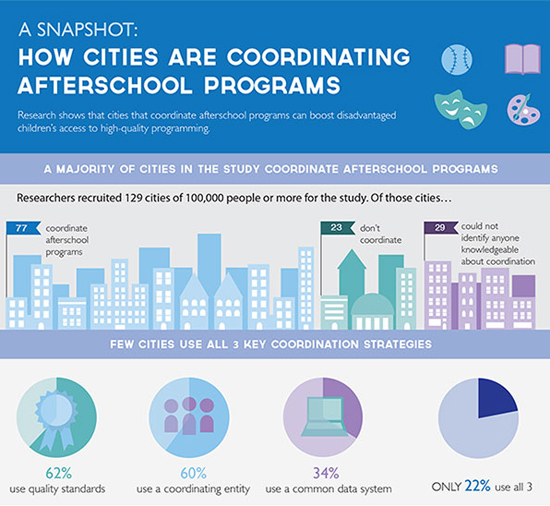
WASHINGTON, D.C. — After-school programs need to be better coordinated in many large cities to serve more children, says a new report.
The report, commissioned by the Wallace Foundation and based on a survey that looked at 129 cities with a population of 100,000 or more, found that 59 percent of the cities responded that they had made efforts to coordinate after-school programs.
Of those, however, less than one-fourth had implemented all three key aspects of coordinating the after-school programs: an entity to help the programs work together, a common data system to track participation and results and standards designed to improve quality.
“Historically, after-school programs have functioned independently with little coordination among provider organizations or agencies, and public and private funders operating in isolation,” the report stated. “The result is often a lack of access to quality programs in U.S. cities, particularly for those young people most in need.”
And that’s still the case in many cities, according to the report by FHI 360, a nonprofit research firm based in Durham, N.C.
As a result of the lack of coordination among programs, report co-author Ivan Charner said: “In some cities, the school system may be running after-school programs. In the same city, the Ys may be running programs, boys and girls clubs may be running programs and what you tend to have is it’s not coordinated.
“You may have parts of the city where three different after-school options are available to students and other parts of the city where there’s nothing because there’s no coordination,” Charner said. “It’s those kinds of things that the coordination can help.”
The Wallace Foundation, which has provided grants to and worked closely with 14 cities to coordinate after-school programs, commissioned the study to determine how well other large cities are coordinating the programs.
Jen Rinehart, vice president of research and policy at the Washington-based Afterschool Alliance, said the study underscores the need for better coordination of after-school programs.
Rinehart said cities the Wallace Foundation has worked with provide strong examples of how to coordinate after-school programs.
“I think [the report] is showing us that there’s more that cities need to be doing to build these effective systems, but at least we do have some good examples of cities that others can look to as they’re doing this work,” she said.
“I think about coordination as this effort to make sure that all kids throughout a city have access to quality, after-school programs.”
Rinehart said one of the report’s findings – that support from a mayor or another city leader improves coordination of after-school programs – jibes with the Alliance’s work with mayors in cities including Providence, Fort Worth and Nashville.
“We really do see mayors or other city leaders as critical linchpins in all of this because they can help push folks at the city level to really make sure the coordination is happening, to make sure that they’re looking at the data and figuring out where there are maybe kids across the city not currently having access to programs and then making sure that those programs are available and then certainly looking at quality in all of those places.”
FHI 360’s Charner said data is critical to coordination of after-school programs. The data should provide information about elements of programs like participation and demographics, attendance, enrollment and outcomes, he said.
But gathering data can be costly, which helps explain why a lot of cities haven’t done it enough, Charner said.
Among surprises in the report’s findings, he said: The size of cities and the proportion of children in poverty didn’t have much effect on how well after-school programs were coordinated.































